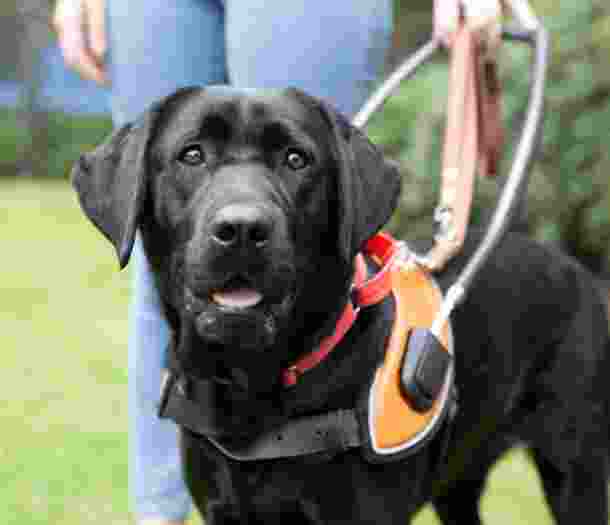What is Guide Dog Mobility training?
Guide Dogs are trained to help you navigate your daily environment and beyond.
Thanks to their unique skills, Guide Dogs can recognise obstacles, cross busy roads, move through large crowds with ease, board public transport, and get you almost anywhere you need or want to go.
Every Guide Dog is carefully selected to match your personality and specific needs, and they’re always on hand to help you achieve your goals. Guide Dogs provide constant support and companionship throughout your partnership, with the average partnership lasting from eight to ten years.
Throughout your partnership, our qualified Guide Dog Mobility Instructors provide ongoing training to ensure you have the skills and confidence you need for years to come.
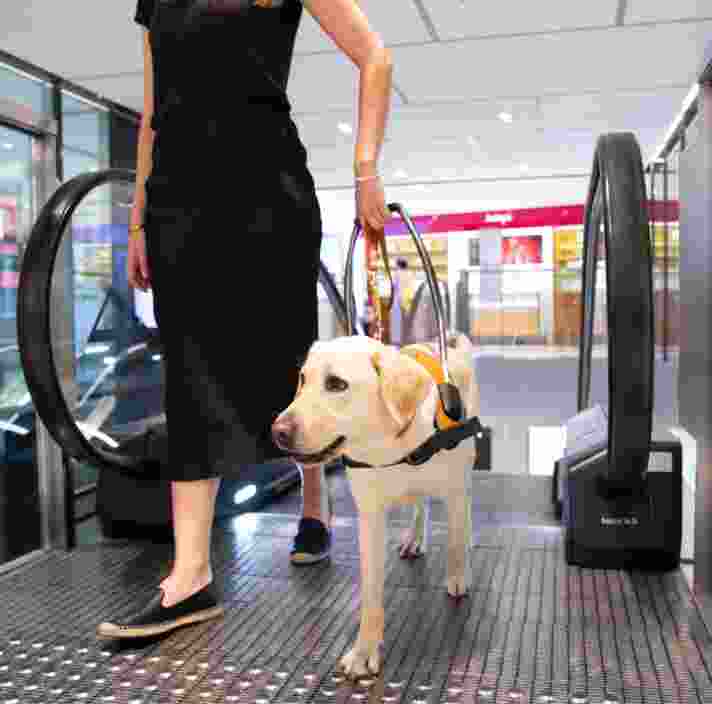
What type of skills can I learn?
Learn the skills to confidently move through your community.
Through Guide Dog Mobility training you can:
- Get around your community safely; go to the shops, travel to work, go to restaurants, attend sports events or movies, and more.
- Maximise your independence and confidence when moving through busy public places.
- Increase your opportunities to socialise and spend more time with others.
- Travel to your favourite or most frequently visited destinations more efficiently.
- Enjoy a greater sense of security, both at home and in the community.
- Develop a genuine bond and enjoy true companionship.
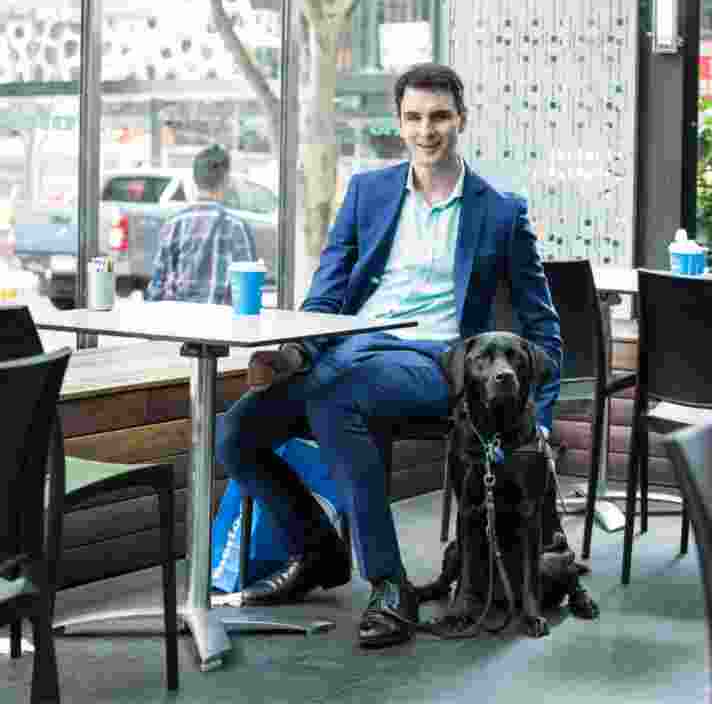
Finding the right match for you.
A carefully selected partner; a life-changing companion.
If you choose to partner with a Guide Dog, you’ll discover a true connection that offers so much more than improved mobility.
The relationship between a Guide Dog and their handler is key to creating the perfect team. We carefully partner Guide Dogs with handlers based on individual needs and lifestyle. A Guide Dog that is right for you will become an invaluable companion to help you achieve your goals and live the life you want.
First, our team of specialist Guide Dog Mobility Instructors perform detailed assessments to identify whether a Guide Dog partnership is right for you. You need to develop solid orientation skills and be able to use a long cane proficiently. These skills form the foundation for handling a Guide Dog, and enable you to work as a team with the dog to access your travel routes and environments safely.
You also need to demonstrate that you either have or can gain the skills you need to care for the dog yourself. For this reason, most people are over the age of 18 before they receive a Guide Dog, but we always look at each case individually.
Then, we learn a little more about your lifestyle, preferred walking speed, and how frequently you travel or enjoy social activities to find a Guide Dog that perfectly meets your needs. This relationship is the foundation for years of improved independence, safety, and confidence.
We train university students, parents with young families, and people who work full-time, part-time, or not in the workforce. We also train seniors and people from non-English speaking backgrounds.
The special bond between a Guide Dog and their handler is as much about friendship and trust, as it is about independence and mobility.
Our Guide Dog Mobility team
By your side every step of the way.
The Guide Dog Mobility team will be by your side every step of the way to ensure the process is right for you. They conduct important initial assessments, provide training before you receive your dog and equip you with all the skills and knowledge you need to feel confident working with your new companion.
Your Guide Dog Mobility Instructor will play a vital role in selecting the perfect dog for you to make sure it will be the right fit for your personality, physical needs, goals and lifestyle. After we’ve found the right dog for you, you will undergo a personalised training program so you can start working with your Guide Dog on your regular travel routes.
Our experienced team are here to support you throughout your entire journey. It doesn’t just stop when you are partnered with your Guide Dog. We will remain in regular contact with you following the placement of your Guide Dog, so you have all the support you need to be a successful team for years to come.
It’s incredible to see the independence and confidence someone can gain from being the support of a Guide Dog. We are here to help the same thing happen for you.
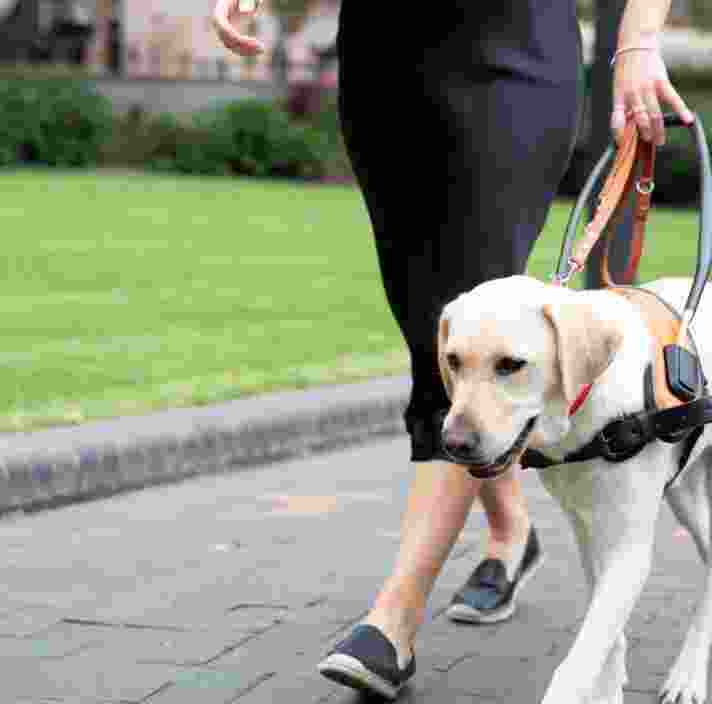
Michael’s story
Guide Dog Libby makes difficult tasks so much easier.
“My guide dog Libby makes difficult tasks so much easier. One of our most special moments together was when she helped me get around the Mater Hospital on my own while my wife had our baby.”
– Michael, Guide dog handler.
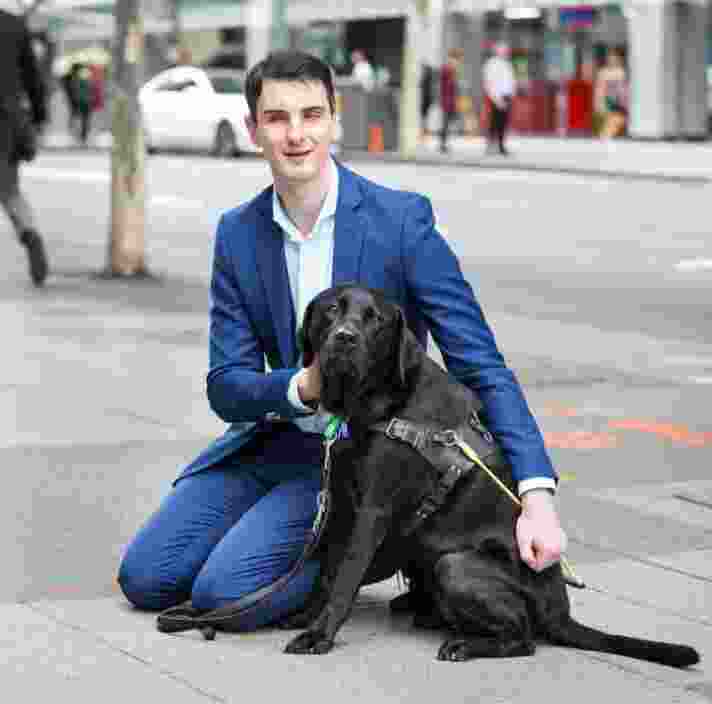
Funding options
You may be eligible for funding support.
You may be eligible for funding support through the National Disability Insurance Scheme (NDIS), meaning the costs of your support could be covered.
We can also help you explore alternative funding pathways.
For more information about funding support, please contact our Client Services team:
Ph: 07 3500 9060
Email: clients@guidedogsqld.com.au
Applying for a Guide Dog
Applying for a Guide Dog
Applying for a Guide Dog
A guide dog is an advanced mobility aid and is a great option if you are already travelling independently with a mobility aid (normally long cane), but wish to travel more fluidly around obstacles rather than contact them (as a long cane does). They are also loving and loyal companions and can help you connect with the community.
Although they are life changing to many clients, they are not suitable for everyone due to many factors, which will be explored through the application process.
Application Process:
1. Pre-screening over the phone.
There are many factors we consider when assessing whether a client would be suitable for guide dog mobility. These include:
- The level of vision loss that causes dependence on a primary mobility aid to ensure safe, independent travel. (Most of our guide dog handlers are legally blind).
- Sufficient work for the guide dog to maintain its safe guiding skills. A broad guide for the amount of work the guide dog would require is approximately 2-3 kilometres a day for 4-5 days a week with a variety of travel routes.
- The physical ability and the appropriate ongoing health status to manage a large, strong, guide dog.
- Financially able to care for a guide dog. Once placed the handler is responsible for all costs relating to the care of the guide dog including vet fees, food, grooming etc. We estimate at least $50 per week but can go much higher if surgery is required for any reason.
2. Interview and assessment in your home with a Guide Dog Mobility Specialist (GDMS)
The GDMS will discuss your current living and travel arrangements, as well as assess one or two of your regular travel routes you currently do with your long cane, independently.
3. Extended assessment on site, if required.
Three day residential class held on site in Bald Hills with other guide dog applicants. You work with a several different dogs to get an idea of the training and commitment required for guide dog mobility.
4. Guide Dog waiting list.
When you have completed and passed the assessment process you will be added to the guide dog waiting list.
Enquiry form
Request a service
FAQ's
Frequently Asked Questions
A Guide Dog is trained to guide a client in a given direction unless told otherwise, avoiding obstacles and ignoring distractions along the route. It will stop at kerbs and steps, find doors, crossings and places which are visited regularly, and it will guide you across the road but it is up to you to decide where and when to cross safely.
The Guide Dog and client are a partnership, with the client giving commands and encouragement and telling the Guide Dog which way to go. The Guide Dog is not infallible, but for some people it can offer a unique, safe and effective way of getting about independently.
The dog will learn your travel routes gradually. However it is a partnership and you need to have knowledge of your environment to support and direct your dog as it guides you through the environment.
The short answer is that they don’t. The decision to cross the road is made by the person working the Guide Dog who decides where and when it is safe to cross.
Like all young dogs, Guide Dogs need regular exercise. It is important that they are exercised whilst working in harness to reinforce and maintain their training. A broad guide for the amount of work the Guide Dog would require would be approximately 2-3 kilometres a day for 4-5 days a week with a variety of travel routes. Many Guide Dog teams work further and more often than this.
If you have a significant vision impairment that makes safe independent travel difficult, you are over 18 years of age and resident in Queensland you can apply for a Guide Dog. Not everyone is suited to working with a Guide Dog and there are many factors that have to be taken into account.
If you are dependent on a primary mobility aid such as a Long Cane to move around safely you may apply for a Guide Dog. Some remaining vision can be useful for recognising where you are on a route and can be used to assist the Guide Dog. Most clients that apply for a Guide Dog are legally blind.
We mainly use Labradors, Golden Retrievers and crosses of these two breeds.
Many people with additional conditions have succeeded in training with a Guide Dog, including those with diabetes, hearing loss and amputees.
There is no upper age limit to work a Guide Dog and we have trained people in their seventies, eighties and even nineties. The main consideration is whether you are able to look after and work a young dog.
We welcome enquiries from anyone who may benefit from working a Guide Dog and we can provide an interpreter to assist during training.
Usually the answer is yes and once introduced the two dogs will generally be fine together. You would also need to consider how you will exercise the two dogs since you cannot work the Guide Dog in harness and lead the pet dog at the same time.
Again, this is not usually a problem. Guide Dogs are generally quite happy around other pets, including cats. If they are introduced carefully then they get to know each other and the Guide Dog will settle in to the home.
The waiting time can vary depending on the length of the waiting list. This is governed by the types of Guide Dogs available at any given time and in some cases the waiting period can be as long as two years. The length of waiting time is dependent upon identifying a Guide Dog that will suit your needs, abilities and lifestyle.
The Guide Dog becomes your responsibility once you have completed training. As with any animal, a Guide Dog also requires day to day care, including grooming, feeding the correct diet, toileting and exercising as well as regular visits to the vet. Our training program will include advice and the practical experience of caring for your Guide Dog. A Guide Dog also needs to be worked regularly.
Guide Dogs are provided to clients on a fee for service basis. All NDIS eligible clients will be required to have guide funding in place before being matched with a Guide Dog. Where there is no funding, the organisation will also provide Guide Dogs at no charge to applicants who complete the application process successfully. Applicants are expected to take responsibility for the care and financial maintenance of their Guide Dog. The minimum cost for caring for a Guide Dog is at least $20 per week but can be much more.
If eligible for NDIS the approximate charges for the application and training process are listed:
Home interview and assessment:
Charges involved – Up to 4 hours plus possibly 5 hours report writing if progressing to the wait list straight away.
Fees – Up to $1845.
Residential Extended Assessment on site in Bald Hills:
Charges involved – 2.5 days group training, 2 nights accommodation, food, report writing.
Fees – Approx $4500. Clients are responsible for organising their own travel to and from Bald Hills.
Guide Dog placement training and first year follow ups
Charges involved – Up to 80 hours individual training, residential class including 4 nights accommodation and food, 3 x 2 hour follow ups and up to 20 hours aftercare if required.
Fees – Approx. $75,000 including training and cost of Guide Dog.
Ongoing assessments 2nd year onwards
Charges involved – Up to 25 hours GDMI and travel.
Fees – Up to $5000 per annum.
Yes – training is as important for you as it is for the Guide Dog, and even experienced Guide Dog Clients need to re-train when they are allocated new dogs. Training usually lasts from three to five weeks depending on each person’s situation and their experience.
During training you would learn how to handle your Guide Dog in the various situations you would encounter when working together. Much of the training takes place outdoors and you would be required to undertake two or three walks a day in different environments.
Learning how to care for the Guide Dog and how to manage it when not working, for example at home, in cafes and restaurants etc, are important aspects of training too. Most clients would agree that although training with a Guide Dog is challenging the rewards and benefits of Guide Dog mobility are considerable.
In most cases employers are happy for the Guide Dog to go into the workplace, and you would probably be using the Guide Dog in order to travel to work. You would need to ensure that there is somewhere suitable for the Guide Dog in the workplace, for example under the desk, and also that you make provision for the Guide Dog to access fresh water and to relieve itself during the day.
GDQ staff are happy to discuss this in more detail with you and your employer if we can assist. Anti-discrimination legislation requires that people with Guide Dogs have access to their workplaces.
The Guide, Hearing & Assistance Dogs Act 2009 and Anti-Discrimination Act in Queensland mean that Guide Dogs are legally allowed in most public places including shops, hotels and restaurants as well as on public transport. However Guide Dog clients unfortunately still experience issues accessing some restaurants and transport providers like taxis and rideshare.
Sometimes it may be more convenient to leave the Guide Dog at home, or it may be that you are going somewhere very noisy or busy and where you do not need the Guide Dog to work. For this reason it is a good idea to get into the habit of leaving the Guide Dog at home occasionally for two to three hours sometimes.
We believe that your Guide Dog should be a pleasure for you to live with. This will happen if the Guide Dog is quiet, clean and well behaved while living with you in your home. During the training period you will be taught how to ensure your Guide Dog behaves well not only at home but out in public too.
Although there are always adjustments to change, the Guide Dog should fit into family life with little disruption. It is important you should be the “leader of the dog” and this role is strengthened by you feeding, working and reinforcing appropriate behaviour in the Guide Dog. In your temporary absence from home it is helpful if a family member is able to maintain the same consistent approach with your Guide Dog.
Guide Dogs are used to interacting with children, so there is little difficulty with them fitting into family life. To assist with the introduction it is important that children do not overwhelm the dog, rush at it, or corner it. They may need a little time to get to know each other, but if the dog is under control and allowed to approach children quietly there will be no problem. The Guide Dog’s bed should be its sanctuary and children should be encouraged to leave the dog in peace when it goes there.
Yes, just like other dogs we believe Guide Dogs need the opportunity to let off steam and have a good run and play, especially with the person who works with them. However the majority of their exercise will be when they are working. They are trained to return when called or when a whistle is used, but like all dogs, they can sometimes be slow to return if they find something interesting.
You will receive regular visits from an instructor and Guide Dogs Queensland will be there to support you and your Guide Dog throughout your working partnership.
Occasionally a titbit or treat can be given as a reward for good work or behaviour but we try to discourage Guide Dogs from sniffing and scavenging so they concentrate while working. Giving titbits randomly and too often can affect their working concentration.
Guide Dog Clients often have a responsible family member or friend they would trust to look after the dog. If this is not the case, Guide Dogs Queensland may be able to assist you with its network of volunteer boarders who look after the dogs. These boarders have received training and understand the importance of being consistent and reinforcing good working practices even when the dog isn’t working.
Legally yes, but there are issues which would need to be covered depending on the country to be visited and length of stay etc. The Australian Quarantine Inspection Service (A.Q.I.S.) provides information on travelling abroad and returning to Australia with animals. Sometimes it may be more convenient to allow your Guide Dog to be boarded at home while you are overseas.
Although you will usually be working your Guide Dog independently soon after returning home it generally takes six months to a year for you and your new Guide Dog to work together smoothly and consistently.
If a problem arises with the Guide Dog you can contact our Guide Dog Services coordinator who will organise for a GDMI to call or visit you if required.
Guide Dogs are usually between eighteen months and two years old when they begin to work and this work will continue for approximately seven to eight years. At the end of its working life you may decide to keep the dog, or may know of a friend or family member who would care for the dog. Guide Dogs Queensland provide a service which selects suitable homes for retired Guide Dogs when people are not able to keep them after they are retired.
Many vision-impaired people travel safely and independently using other forms of mobility. If during your application you decide that a Guide Dog is not the right mobility aid for you, we will discuss other services we can offer for your consideration.
Unfortunately, we’re unable to train or certify dogs that have not come from our approved breeding and training program. This ensures every guide dog meets the highest standards for health, temperament, and training.
To find approved trainers and training institutions in Queensland, visit the Queensland Government’s Approved Trainers and Training Institutions page.
Phone: (07) 3500 9060
Email: clients@guidedogsqld.com.au
